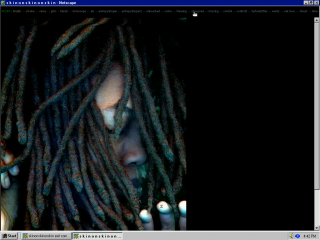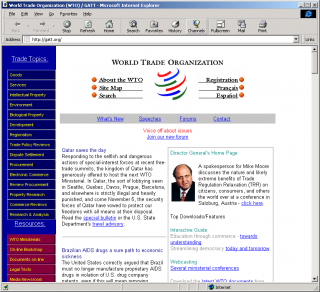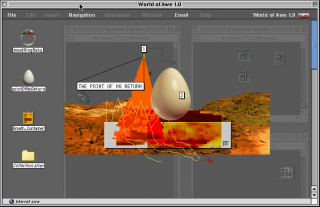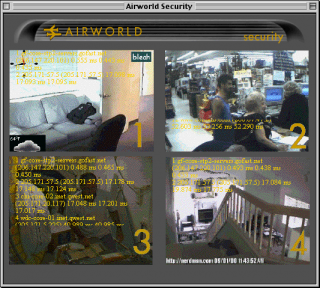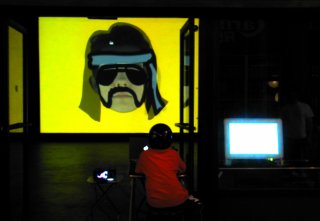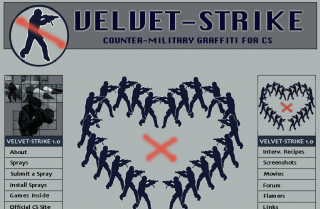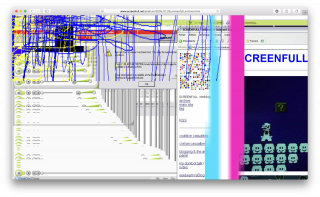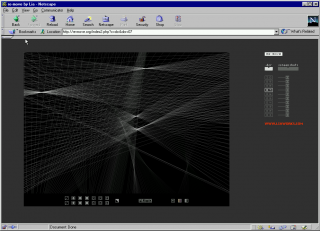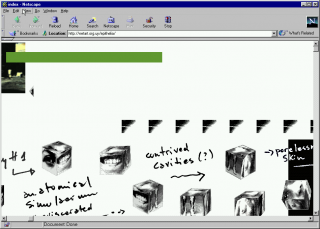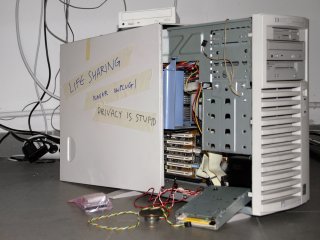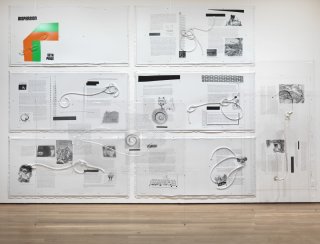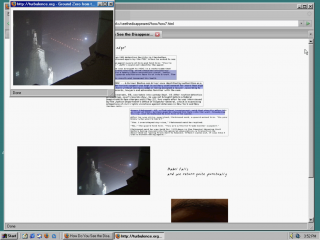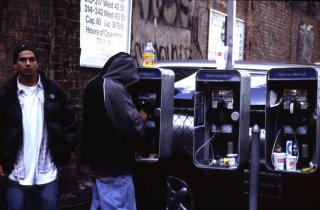Black Net.Art Actions
Mendi + Keith Obadike
2001-2003
Mendi + Keith Obadike’s Black Net.Art Actions is a suite of new media artworks produced in 2001-2003. Each work in the Black Net.Art Actions can be thought of as a standalone work, or as a module in the couple’s larger, ongoing public performance.
Net Art Anthology presents three of the works in the series: Blackness for Sale (2001), a tongue-in-cheek intervention into the budding system of e-commerce on the consumer internet; The Interaction of Coloreds (2002), a website that looks at new manifestations of colorism and its potential role in online surveillance; and Keeping Up Appearances (2001), a “hypertextimonial” work by Mendi that follows in the tradition of Black Feminist personal narratives.
The Black Net.Art Actions all take different forms, but share a conceptual interest in discourses of color and race, and the racialization of the internet–issues which were often glossed over in net art discourse. Taken as a whole, the actions can be understood as an attempt to reformulate net art with race as a central concern.
“We did not feel that the net was a colorless space, but rather, that whiteness was being set up as the default.”
—Mendi Obadike
Read Simone Browne’s text on the Black Net.Art Actions
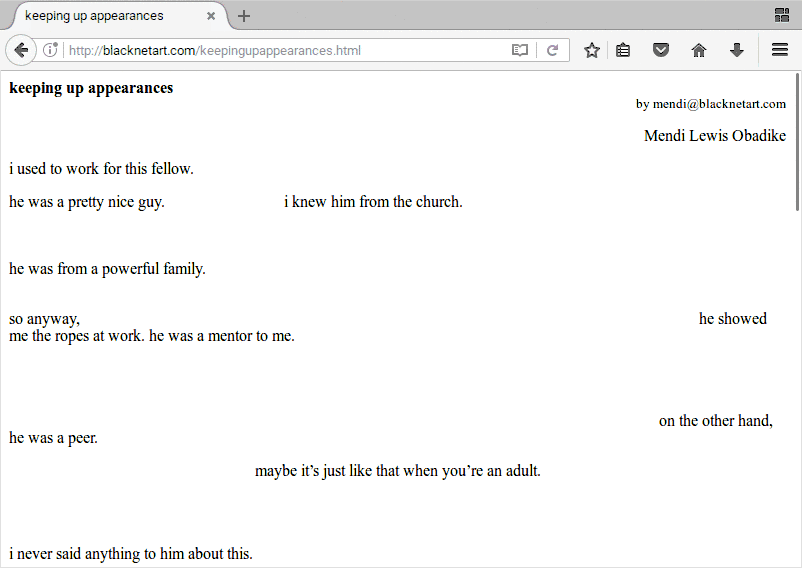 Keeping Up Appearances, Mendi Obadike, 2001
Keeping Up Appearances, Mendi Obadike, 2001
VISIT WORK
Keeping Up Appearances is a “hypertextimonial” in which Mendi Obadike recounts her interactions with a much older white male mentor as a young black woman. At first glance, the work appears to consist only of black, nonreactive Times New Roman text snippets, which make some sense on their own but fail to come together as a coherent narrative.
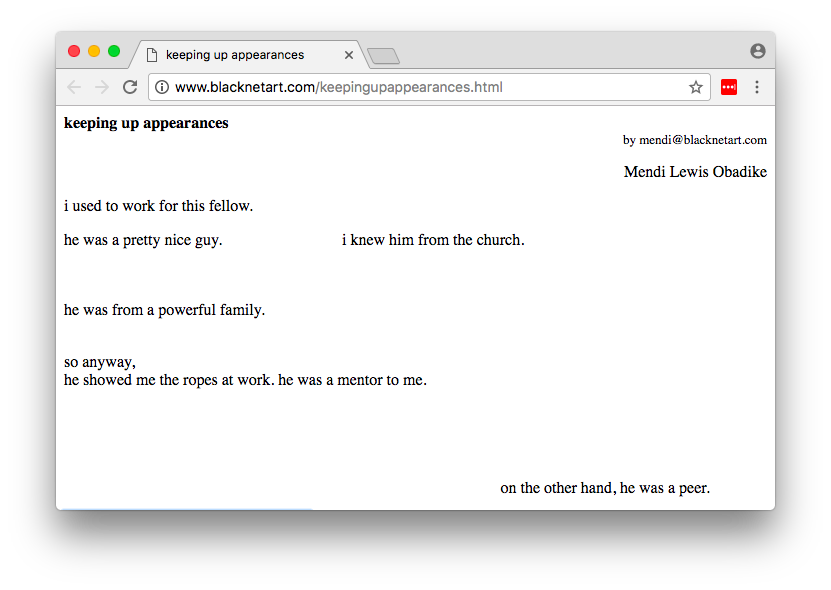 Keeping Up Appearances, Mendi Obadike, 2001
Keeping Up Appearances, Mendi Obadike, 2001
Mousing over the page reveals lavender text that fills in the blanks to reveal a series of confessional asides, the literal subtext of her interactions with the man—his over-familiarity and her silence.
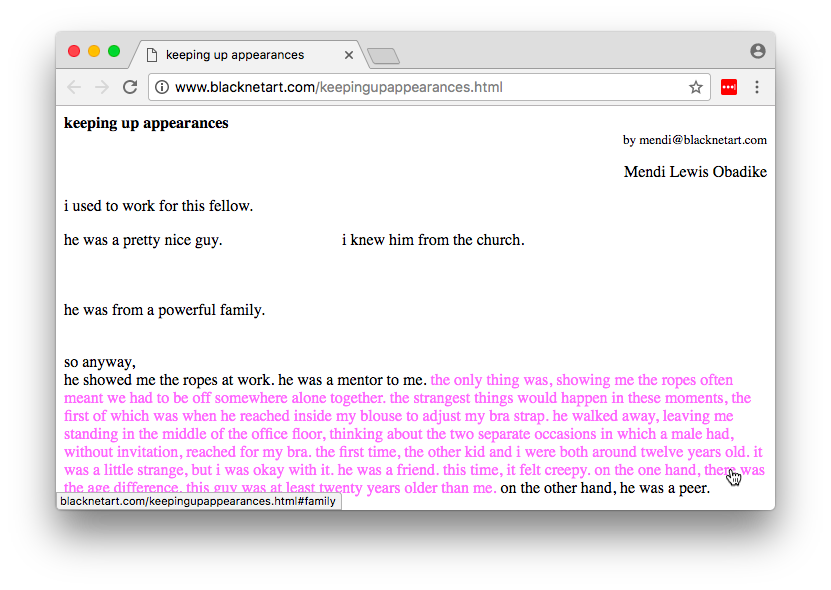 Keeping Up Appearances, Mendi Obadike, 2001
Keeping Up Appearances, Mendi Obadike, 2001
Notably, Keeping Up Appearances is not interactive, unlike many other hypertext works. Purely a spectator, unable to intervene in Mendi’s narrative, the user is reminded of the historical inevitability of dynamics such as the one she describes.
“I have bombarded the viewer with disappearing hypertext as a way to work back into the smallness I might model in my day-to-day life.”
– Mendi Obadike
Artists and writers like Audre Lorde, Faith Ringgold, and many others have discussed what might be called a politics of silence in the experiences of Black women, where silence can be at once disempowering and a necessary means of survival in the face of oppression. Mendi follows Lorde in asking, “how do I disclose?”
“I have been thinking about the challenges black women autobiographers face when it comes to disclosure. I am particularly interested in the way their narratives are often heavily structured by silences or denials.” —Mendi Obadike
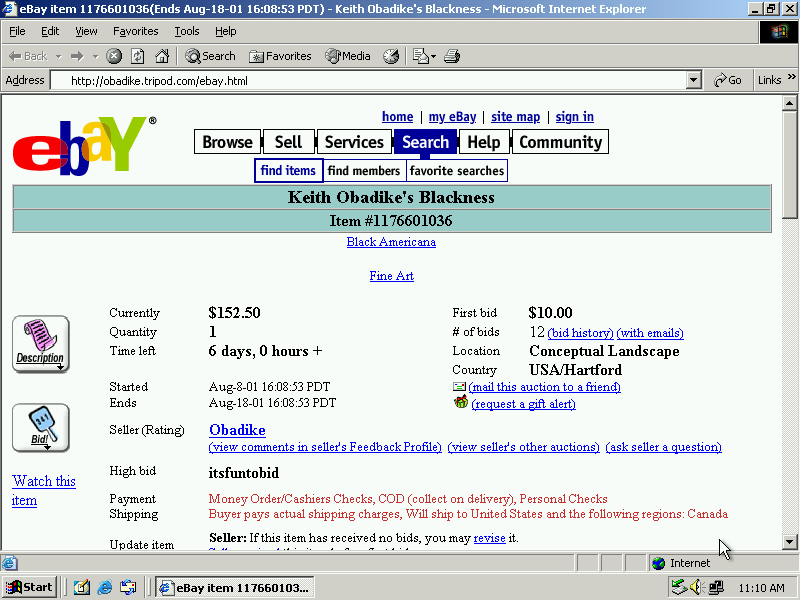 Blackness for Sale, Mendi + Keith Obadike, 2001
Blackness for Sale, Mendi + Keith Obadike, 2001
VISIT WORK
In August 2001, Mendi + Keith Obadike placed Keith’s “blackness” up for auction on eBay.com in the site’s “Black Americana” category. The listing included no image, only a lengthy description of the “Benefits and Warnings” of the item. The winning bidder would receive a certificate of authenticity.
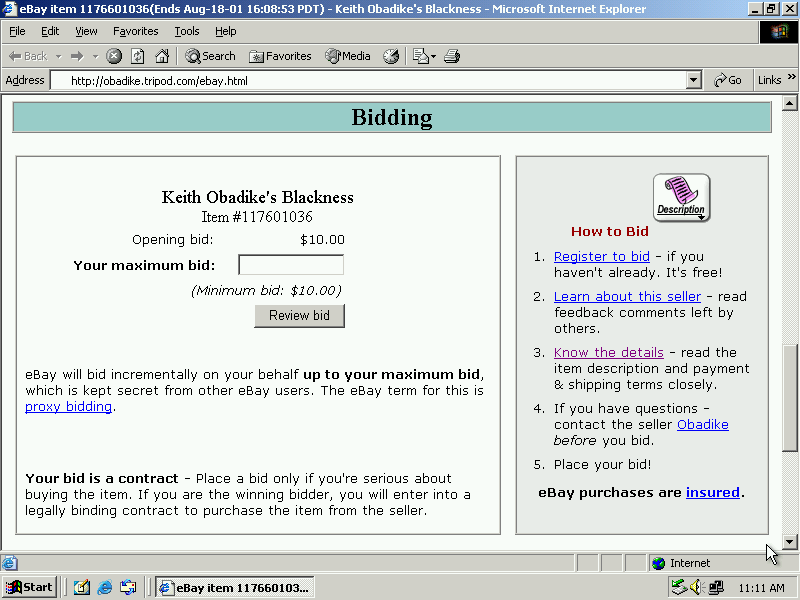 Blackness For Sale, Mendi + Keith Obadike, 2001 (detail)
Blackness For Sale, Mendi + Keith Obadike, 2001 (detail)
“1. This Blackness may be used for creating ‘black art’”
“7. The Seller does not recommend that this Blackness be used while demanding fairness.”
At the time of Blackness for Sale, a new wave of net artists were beginning to explore the internet’s growing role in commerce, often focusing on the relationship between the self and new online marketplaces. In most cases, these artists glossed over the central role played by blackness in the longer history of commodification of bodies and subjects.
“I was also very tired of the trend of net.artists posing as corporations and not really saying much. While watching what many were doing with net.art, I didn’t really see net artists dealing with this intersection of commerce and race.”
—Keith Obadike
 Mendi + Keith Obadike
Mendi + Keith Obadike
Blackness for Sale draws a connection between the commodification of black bodies during American slavery and the commodification of blackness on the internet. The Obadikes placed Keith’s “blackness” specifically in the “Black Americana” category of eBay, calling attention to this existing marketplace, just one of many sites of transaction where blackness is something to be bought and sold. eBay’s auction format, when it comes to “Black Americana” and Blackness for Sale, conjures up the auction block as ground zero for the commodification of blackness.
 Blackness For Sale, Mendi + Keith Obadike, 2001 (detail)
Blackness For Sale, Mendi + Keith Obadike, 2001 (detail)
eBay removed the Obadikes’ listing after only four days, citing “inappropriateness.” This act of censorship functioned as an inadvertent intervention-into-an-intervention, prompting questions about the terms under which blackness is permitted to enter the marketplace. The black ephemera—including images and figurines featuring racist caricatures—that circulates on eBay is deemed appropriate, while Keith’s blackness is not.
The listing separated Keith’s blackness from his body, highlighting the absurdity of notions of the internet as a place to try on different identities and avatars unrelated to one’s lived experience. By offering up Keith’s blackness to potentially non-black buyers, the Obadikes reframed these practices as new manifestations of a longstanding dynamic in which blackness is understood as something that can be donned at will, gesturing toward the historical practice of blackface and prefiguring the contemporary appropriation of black language, fashion, and even identity.
“Many people understand blackness as something that lives in the realm of vision and because there was no photo on the auction page it gave room for some to fantasize about how they would occupy this space.”
—Keith Obadike
The Obadikes chose to auction Keith’s blackness in part because black maleness is normative and could therefore be read as ungendered, in a way similar to whiteness’ reading as unraced. This choice, along with the choice to post the listing without a photo, leaves space for the visitor to project their own racial imaginary.
 Following eBay’s censorship of the auction, the Obadikes reconstructed the auction page in HTML, creating a non-functional duplicate that stands in for the original. Keith’s blackness is now always on sale, but never finally sold.
Following eBay’s censorship of the auction, the Obadikes reconstructed the auction page in HTML, creating a non-functional duplicate that stands in for the original. Keith’s blackness is now always on sale, but never finally sold.
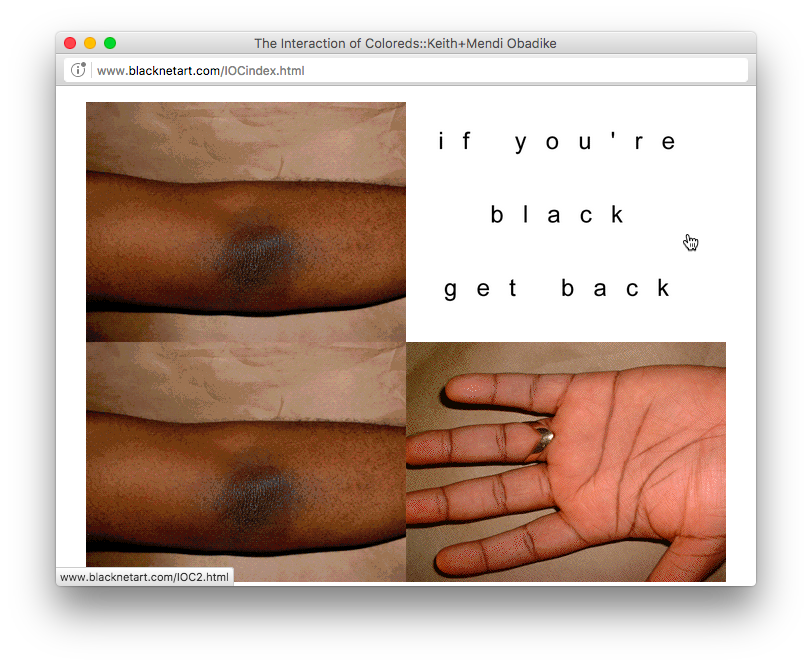 The Interaction of Coloreds, Mendi + Keith Obadike, 2002. Commissioned by the Whitney Museum of American Art for its artport website.
The Interaction of Coloreds, Mendi + Keith Obadike, 2002. Commissioned by the Whitney Museum of American Art for its artport website.
VISIT WORK
IOC Audio, Mendi + Keith Obadike. Play this soundtrack while browsing the site.
The Interaction of Coloreds is a browser-based work that administers a “digital brown paper bag test” to visitors, toying with historical systems of racial categorization and contemporary discourse around digital surveillance.
The “brown paper bag test” originated during slavery in the Americas and was used to separate the “light” from the “dark” in order to decide who would work in the master’s house (light-skinned) or in the fields (dark-skinned) and receive the social benefits—or drawbacks—associated with each. The shade of a paper bag was the cut-off point. The practice continued post-slavery in employment practices and school admission, as well as in black communities and organizations such as churches, fraternities, and sororities. Today, it lives on in the social realm through rampant, if veiled, colorism—discrimination against individuals with darker skin tones while privileging those with lighter skin.
The Interaction of Coloreds can be found on the Whitney Museum’s Artport website, where the work lives as a part of the museum’s permanent collection. It begins with a popup window, divided into four quadrants, featuring animations that rapidly cycle through images of body parts in various shades of brown. Mousing over each quadrant reveals a different message: “If you’re white you're right.” “If you’re black get back.” “If you’re brown stick around.” “If you’re yellow you’re mellow.”
From here, the user clicks through to a page featuring language that seems to be selling a product: “PROTECT YOUR PORTAL! Websafe colors aren’t just for webmasters. Register with the IOC Color Check System® and protect your online community from unwanted visitors.”
 The Interaction of Coloreds, Mendi and Keith Obadike, 2002
The Interaction of Coloreds, Mendi and Keith Obadike, 2002
 The Interaction of Coloreds, Mendi and Keith Obadike, 2002
The Interaction of Coloreds, Mendi and Keith Obadike, 2002
The IOC Color Check system (the brown paper bag test) is a lengthy online form that asks basic questions like, “How do you currently identify racially?” as well seemingly absurd questions like, “has anyone ever checked for your color behind your ears?” Other prompts are very personal: “List all the slurs you have ever been called by strangers.” Others are comical: “Do you get ashy?” “Do you know what ashy is?”
The IOC Color Check System promises to provide users with an official hex code for their skin color and register them in an “international database.”
 The Interaction of Coloreds, Mendi and Keith Obadike, 2002
The Interaction of Coloreds, Mendi and Keith Obadike, 2002
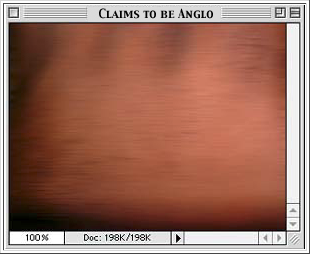 Image used in The Interaction of Coloreds, Mendi + Keith Obadike, 2002
Image used in The Interaction of Coloreds, Mendi + Keith Obadike, 2002
The Obadikes’ Color Check System’s promise to provide an objective index of race speaks to growing anxieties around fixed user identity that accompanied the turn to consumer use of the net. Assigning every user a hex code allows others to know who you really are online, and restrict access accordingly.
“Do you represent a money-lending institution? Do you need online skin color verification for the purposes of determining projected property value?”
The Interaction of Coloreds suggests that the correlative relationship between race, money, and mobility persist online. The arrival of e-commerce and introduction of the net to a wider consumer base only made the internet more like meatspace—mediated by capital.


